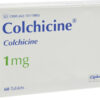Medication Overview
Celebrex, with the generic name celecoxib, is classified as a nonsteroidal anti-inflammatory drug (NSAID) that selectively inhibits cyclooxygenase-2 (COX-2). Primarily, it is prescribed for the management of pain and inflammation associated with various conditions such as arthritis. Unlike traditional NSAIDs, Celebrex is specifically designed to reduce the likelihood of gastrointestinal side effects, which are common with non-selective COX inhibitors.
Pharmacological Properties
The active ingredient, celecoxib, is highly selective for COX-2 enzymes. By selectively targeting COX-2, Celebrex primarily reduces the synthesis of prostaglandins, which play a significant role in inflammation and pain signaling pathways. The molecular weight of celecoxib is 381.38, and its chemical designation is 4-[5-(4-methylphenyl)-3-(trifluoromethyl)-1H-pyrazol-1-yl]benzenesulfonamide. Celebrex is formulated as capsules for oral administration, with varying strengths including 50 mg, 100 mg, 200 mg, and 400 mg.
Approved Indications
Celebrex is commonly indicated for the treatment of osteoarthritis and rheumatoid arthritis to alleviate pain and inflammation. It is also approved for managing ankylosing spondylitis, juvenile rheumatoid arthritis in patients aged two years and older, and primary dysmenorrhea. Patients experiencing acute pain, particularly musculoskeletal pain, may also benefit from Celebrex. It is used off-label in certain conditions, as determined by a healthcare provider.
Administration Guidelines
The medication should be taken orally, with or without food. For patients who experience gastrointestinal discomfort, ingestion with food may be preferable. Capsules should be swallowed whole, without crushing or breaking them. The dosing regimen depends on the specific condition being treated and should be tailored according to the physician’s guidance. Typically, it is administered once or twice daily. Adherence to prescribed dosing intervals is essential for optimal efficacy.
Dosage Recommendations
For osteoarthritis, the typical starting dose is 200 mg per day, which can be administered as a single dose or divided into two doses. In cases of rheumatoid arthritis, the recommended dose is 100 mg to 200 mg twice daily. When treating acute pain, the initial dose can be 400 mg, followed by an additional 200 mg if needed on the first day. Maintenance dosing for dysmenorrhea is 200 mg twice daily. The smallest effective dose should be used for the shortest duration to minimize potential adverse effects.
Mechanism of Action
Celebrex exerts its therapeutic effects by selectively inhibiting the COX-2 isoenzyme. This inhibition results in decreased formation of prostaglandins that mediate inflammation, pain, and fever. Unlike non-selective NSAIDs, Celebrex spares COX-1, which is involved in protecting the gastric mucosa. This selective action potentially reduces the risk of gastrointestinal ulceration associated with chronic NSAID therapy.
Pharmacokinetics Profile
After oral administration, celecoxib is absorbed moderately, achieving peak plasma concentrations approximately three hours post-dose. The bioavailability of the drug is enhanced when taken with a high-fat meal. Celecoxib is extensively metabolized in the liver, predominantly via the CYP2C9 isoenzyme. The terminal half-life of the drug ranges from 11 to 16 hours, allowing for once or twice daily dosing in most patients. Celebrex and its inactive metabolites are excreted in the urine and feces.
Pediatric and Geriatric Use
In pediatric populations, Celebrex is approved for juvenile rheumatoid arthritis in patients aged two years and older. Dosing is weight-based and should be carefully adjusted to minimize adverse reactions. For geriatric patients, careful monitoring is advised, particularly in those with compromised renal or hepatic function. Dosage adjustments may be necessary based on clinical response and tolerance assessments for this demographic.
Drug Interactions Overview
Celebrex can interact with other medications, including anticoagulants like warfarin, which may potentiate bleeding risk. Concomitant use of other NSAIDs or corticosteroids increases the potential for gastrointestinal bleeding. It may also reduce the effectiveness of ACE inhibitors and diuretics, impacting blood pressure control. CYP2C9 inhibitors can elevate celecoxib levels, necessitating dose modifications. Regular reviews of the complete medication regimen are recommended to identify potential interactions.
Contraindications and Implications
Use of Celebrex is contraindicated in patients with a known hypersensitivity to celecoxib, sulfonamides, or any component of the formulation. It should be avoided in individuals with a history of aspirin-exacerbated respiratory disease or NSAID-related asthma. Additionally, patients who have undergone recent coronary artery bypass graft (CABG) surgery should not receive Celebrex. Consideration of patient-specific health conditions is crucial before initiating therapy.
Storage and Handling Instructions
Celebrex capsules should be stored at controlled room temperature and protected from moisture. They should be kept in their original container, with the lid tightly closed when not in use to maintain stability and potency. The medication should be kept out of reach of children and disposed of properly following the expiry date or as per local regulations for pharmaceutical waste management.





Reviews
There are no reviews yet.